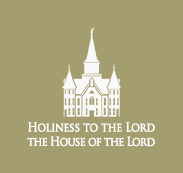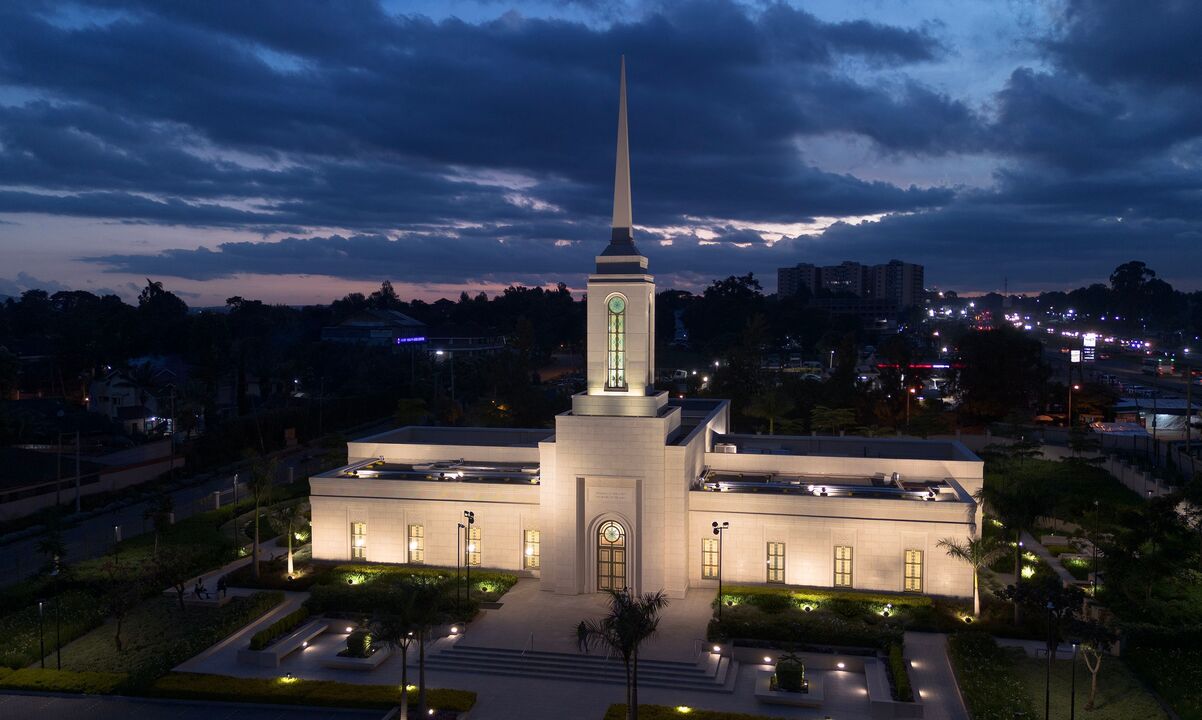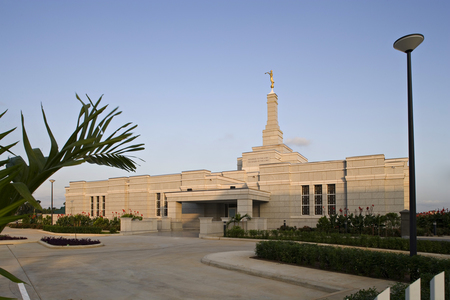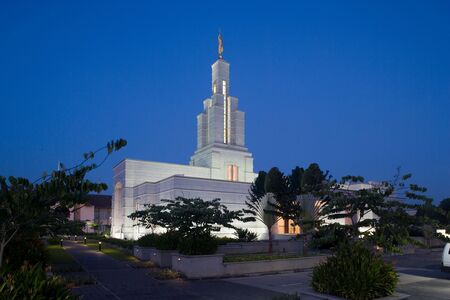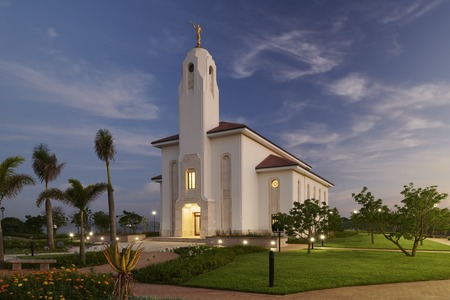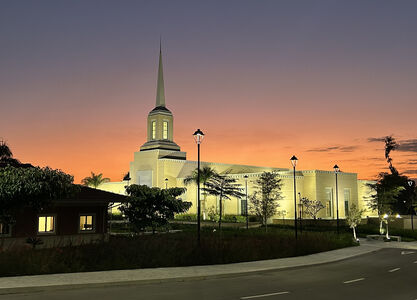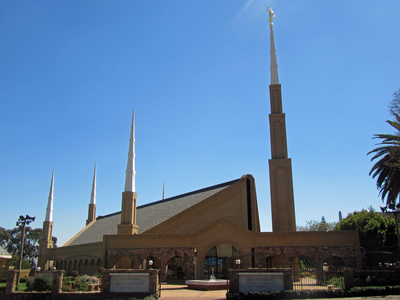Services
NO visitors' center open to the publicNO arrival center available
Patron housing available
NO distribution center on site (Store Locator)
Announcement:
2 April 2017Groundbreaking and Site Dedication:
11 September 2021 by Joseph W. SitatiPublic Open House:
17 April–3 May 2025 | 16 daysDedication:
18 May 2025 by Ulisses SoaresSite:
3.435 acres | 1.4 hectaresExterior Finish:
Portuguese Moleanos limestoneArchitectural Features:
Single attached end spireOrdinance Rooms:
Two instruction rooms, two sealing rooms, and one baptistryTotal Floor Area:
19,870 square feet | 1,846 square metersHeight:
107 feet 3 inches | 32.7 metersElevation:
6,081 feet | 1,854 metersTemple Locale
The Nairobi Kenya Temple is a beautiful landmark that stands in the Mountain View neighborhood of Nairobi on Waiyaki Way (or A104 Road), a major highway in Southwest Kenya. The African lily is a major design inspiration found in the art glass and throughout the interior. Sharing the property is a large ancillary building that houses a meetinghouse, arrival facilities, and housing for patrons. A marble reproduction of Thorvaldsen's Christus statue stands in the front courtyard of the building.
Temple Facts
The Nairobi Kenya Temple was the ninth temple built in Africa and the first built in East Africa (and Kenya).
Temple History
Background
In February 1998, President Gordon B. Hinckley—accompanied by Elder Jeffrey R. Holland of the Quorum of the Twelve Apostles—embarked on an international tour of five African countries and locations in Canada, the Canary Islands, and Cape Verde.
During the afternoon of February 17, 1998, President Hinckley arrived in Nairobi, Kenya, where he addressed some 900 members in a conference room at his hotel. Members were elated to meet the prophet and traveled from as far as Ethiopia, Somalia, Tanzania, and Uganda to be with him. Because not all could afford a trip to Nairobi, some members joined their money together to send representatives who could come back and relate the experience of being with the prophet of the Lord. During his remarks, President Hinckley said, "There isn't the slightest doubt in my mind that the time will come if you will walk in faith and patience that a temple will be built in this land to serve the needs of this people. Now, don't count on it for a few years,…but it will be so."1
Announcement
During his opening remarks at the Sunday Morning Session of the 187th Annual General Conference, President Thomas S. Monson announced that a new temple would be constructed in the city of Nairobi, Kenya. It would be the ninth temple constructed on the continent of Africa. There were three dedicated temples in Africa, including the Aba Nigeria Temple, Accra Ghana Temple, and Johannesburg South Africa Temple. Two temples were under construction: the Kinshasa Democratic Republic of the Congo Temple and the Durban South Africa Temple. And two other temples, in addition to Nairobi, had been announced: the Abidjan Ivory Coast Temple and the Harare Zimbabwe Temple.2
There were two stakes and six districts organized in the nation of Kenya with three stakes in neighboring Uganda. Many other Saints living in the outlying regions of East Africa, who traveled to the distant Johannesburg South Africa Temple, would be immensely blessed by a closer temple.
Media Event
On June 14, 2017, a media event was held to familiarize members of the press with the recently announced Nairobi Kenya Temple. A variety of media outlets and opinion leaders were in attendance. Elder Joseph W. Sitati of the Seventy was the key speaker, addressing the importance of temples and fielding questions from attendees.
Site
The site of the Mountain View Ward meetinghouse in northwestern Nairobi was selected as the location for the Nairobi Kenya Temple.
Rendering
On July 14, 2021, the official exterior rendering of the Nairobi Kenya Temple was released.
Groundbreaking
On September 11, 2021, ground was broken on East Africa's first temple at the Mountain View chapel in Nairobi, Kenya, under the direction of Elder Joseph W. Sitati, president of the Africa Central Area. Speaking of the effect of the temple on the rising generation, Elder Sitati said: "This is the place they will get married; this is the place where they will make eternal covenants that will bless them for all eternity." The Nairobi Kenya Temple was "wholly welcomed" by the Right Honorable Raila Odinga, former Prime Minister of Kenya, who had a message read at the service. Among his words, he said: "At a very difficult time, members of the Church have been at the forefront, giving us reason to hope."3
Open House and Dedication
The open house for the Nairobi Kenya Temple began with a media day on Monday, April 14, 2025, followed by two days of tours for invited guests. The public was invited to tour the temple from Thursday, April 17, through Saturday, May 3, excluding Sundays. The temple was dedicated by Elder Ulisses Soares of the Quorum of the Twelve Apostles on Sunday, May 18, 2025. The dedicatory session was broadcast to all units in the temple district.4
Temple Design
Exterior
The Nairobi Kenya Temple is a cast-in-place concrete structural frame, with concrete block partitions and stone veneer. The exterior stone veneer is Portuguese Moleanos limestone.
Surrounding the temple is a fence made from concrete block, with a painted plaster finish.
Interior
Floral motifs are a theme in this temple, as Nairobi is one of the largest exporters of flowers on the African continent. The agapanthus, or African lily, with its vibrant blue-lavender hue, is a key motif in the art glass and interior decorative painting. The interior furniture often reflects British colonial design, while traditional motifs are used in the textiles. The exterior’s designs incorporate the African lily, circles, and repeated patterns with native influences.
The temple’s flooring features Milliken carpet, nylon rugs, and porcelain Cerim Marfil stone with Quartzite Blue and Verde Imperiale accents. Stone skirtings are made of Portuguese Moleanos limestone.
The interior walls use neutral tones, as inspired by the Kenyan savanna. No wall coverings were used inside the temple.
The art glass design is a stylized floral pattern, primarily of blues and greens consistent with the African lily (Agapanthus) flower.
The lighting throughout the interior includes fixtures made of brass and crystal.
Doors are solid sapele mahogany sourced domestically. Sapele mahogany is considered a sustainable indigenous timber with a consistent grain and color range suitable for a temple. Throughout the temple, hardware for the doors has been selected to complement the design motifs in the floral art glass and features bronze and brass finishes. The celestial room, however, uses hardware with a French gold finish.
The ceilings are made of flush plasterboard (Gyproc) and suspended grid tiles (OWA lay-in ceiling tiles).
The temple’s millwork is made of sapele mahogany timber. Extensive patterning is present in the altars, pews, recommend desk and instruction room proscenium that complement the art glass, floral arrangements and geometric motifs.
Original artwork used in the interior includes “The Masai Water Tower Kenya” by Paul Augustinus, “Oloololo Escarpment in the Rift Valley Kenya” by Paul Augustinus and “Nairobi Landscape” by Oscar Campos.
Church History in Kenya
Faith in Jesus Christ, patience and service characterize the history of The Church of Jesus Christ of Latter-day Saints in Kenya.
A small group of Church members, consisting primarily of expatriates, worshiped together in members’ homes in Kenya in the 1960s, operating as an official branch from 1967 to 1970. During this period, Kenyans living abroad also learned about the Church, and a few were baptized.
Church President Spencer W. Kimball received a revelation in June 1978 that extended the blessings of the priesthood and the temple to all worthy members, regardless of race. This opened the door to the growth of the Church in Africa. In 1979, Elizaphan Osaka; his wife, Ebisiba; and their two oldest children, Margaret and Jairo, were the first Kenyans to be baptized in their country. A year later, the first missionaries to serve in Kenya, Farrell and Blanche McGhie, arrived in Nairobi and began the long process of registering the Church with the Kenyan government. Without registration, the Church could not proselytize or own property. Nevertheless, membership continued to grow by word of mouth, and the first district was created in 1981 with branches in Nairobi and Kiboko.
Brothers Nickson and Benson Kasue were baptised in a small gathering in Nairobi in February 1985. Their older brother, Julius, was baptised on Feb. 4, 1986. Church leaders authorised Julius to start a Sunday School and administer the sacrament in his father’s home in Chyulu Hills.
Church members in the United States and Canada fasted on Jan. 27 and Nov. 24, 1985, and donated the cost of meals skipped, totaling over $10 million, to victims of a devastating famine in Africa. The Ngorika Water System was built for $300,000 in partnership with local Kenyans, who performed much of the labor, although no Church members lived in the region at the time. The system supplied drinking water for 1,100 dwellings in 15 villages in central Kenya.
By the end of 1987, 182 native Kenyans had joined the Church, including Joseph W. and Gladys Sitati and their children. Leaders recognized the Church’s tenuous legal status in Kenya and were concerned that continued activity jeopardized official recognition. As a result, in July 1989, they stopped all missionary lessons, suspended baptisms and withdrew all foreign missionaries. Joseph Sitati was named presiding elder for the country.
In addition to the Church’s formal applications, several members lobbied government leaders in support of registration. Members in Kenya, organized by Sitati, fasted together for the Church to be successfully registered.
Eventually, these efforts led to a meeting with Kenyan President Daniel Arap Moi on February 5, 1991. Joseph Sitati and Jim Dott, an attorney representing the Church, presented another formal petition for registration. President Moi received it positively and, on February 21, 1991, the Church was officially registered. The Kenya Nairobi Mission was organized on July 1, 1991, covering Kenya, Tanzania, Uganda and later Ethiopia. Members primarily worshiped in Nairobi and Chyulu, speaking English, Kiswahili and Kikamba.
In October, Elder James E. Faust of the Quorum of the Twelve Apostles visited Nairobi and dedicated Kenya for the preaching of the gospel of Jesus Christ. Faust prayed for the elimination of hate, for mutual respect among the people of Kenya and that Church members would have access to a temple.
By 1992, farms in the Chyulu region were under great stress from ongoing drought. Famine was imminent. The Church responded with food deliveries. It also began purchasing plots in the region where families from the community planted drought-resistant crops.
The Church dug wells, provided storage tanks and water lines and provided instruction on farming best practices. In October 1992, local members planted maize in the dry ground, despite the drought. They held a special fast for rain, and less than one week after planting, rain fell in an area that had seen no rainfall for almost two years. “The crops grew, and so did the faith of the people.” The Church also provided food and other supplies for refugees congregated in Kenya near the Somali border.
The first permanent Church-built chapel in East Africa was completed in 1994 in the Langata area of Nairobi. A stake center in the Buruburu area was completed a short time later.
In January 1996, the Kenyan government, acting on unfounded rumors and criticism, expelled all young, non-Kenyan Latter-day Saint missionaries from the country. Senior missionaries were allowed to stay and continue serving along with young Kenyan natives. Leaders accelerated efforts to prepare local youth to serve and teach. By 1998, the government relaxed restrictions and began allowing a few young non-Kenyans to serve in the country.
Church President Gordon B. Hinckley visited Kenya in February 1998. He taught members that righteous living would bring prosperity and a temple to Kenya. “There isn’t the slightest doubt in my mind,” Hinckley said, “that the time will come if you will walk in faith and patience, that a temple will be built in this land to serve this people.”
The Church grew steadily in the following decade. A full translation of the Book of Mormon to Swahili (Kiswahili) was published in 2000. The first stake (similar to a diocese) in East Africa was organized in Nairobi on Sept. 9, 2001, with more than 1,700 members. The Church continued building chapels to accommodate the growth, and in July 2005 the Kenya Nairobi Mission was divided.
Kenyan members regularly traveled long distances to temples in Johannesburg, London and Accra to make sacred covenants with the Lord and be sealed as families for eternity. These trips required great personal sacrifice, and many were assisted by the Church’s Temple Patron Fund.
Today over 22,000 members of the Church worship in 74 congregations across Kenya. Latter-day Saints strive to follow the teachings and example of Jesus Christ to relieve suffering and serve their neighbors. In recent years, members of the Church, working with partner organizations, have supplied thousands of tons of food and tens of millions of dollars to feed refugees and other impoverished people. In Kenya, the Church continues to cooperatively sponsor and fund programs such as vaccination campaigns, clean water projects, hygiene and sanitation efforts and job training. In 2023, work in Kenya included projects supporting entrepreneurship for women, enhancing the quality of maternal and newborn care and improving food security and nutrition. These services are offered without regard to recipients’ faith or church membership.
In December 2024, the Church facilitated a “Giving Machine” in Nairobi, engaging Kenyans of all faiths and backgrounds to relieve the suffering of the less fortunate.
The Nairobi Kenya Temple will be the first temple in the country, continuing the Church’s long history of building these sacred structures that allow members to make covenants with the Lord Jesus Christ.
- "President Hinckley Uplifts Members in Nova Scotia, Africa, Northern Mexico," Ensign May 1998: 110–116.
- "President Monson Announces Five New Temples," The Church of Jesus Christ of Latter-day Saints News Release, 2 Apr. 2017.
- "'A reason to hope': Nairobi Kenya Temple Groundbreaking," The Church of Jesus Christ of Latter-day Saints News Release, 11 Sept. 2021.
- "Open House and Dedication Announced for Nairobi Kenya Temple," The Church of Jesus Christ of Latter-day Saints News Release, 13 Jan. 2025.
